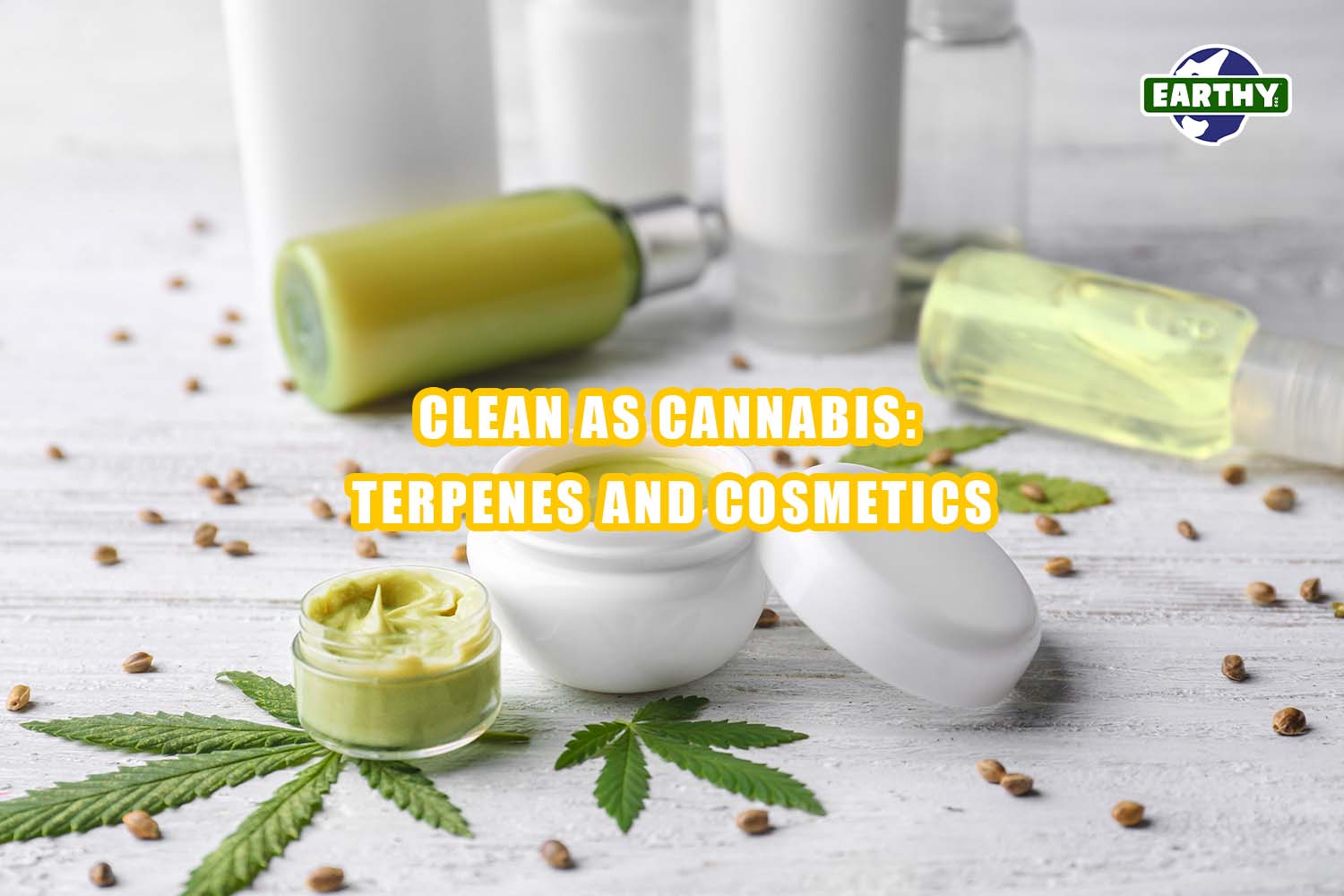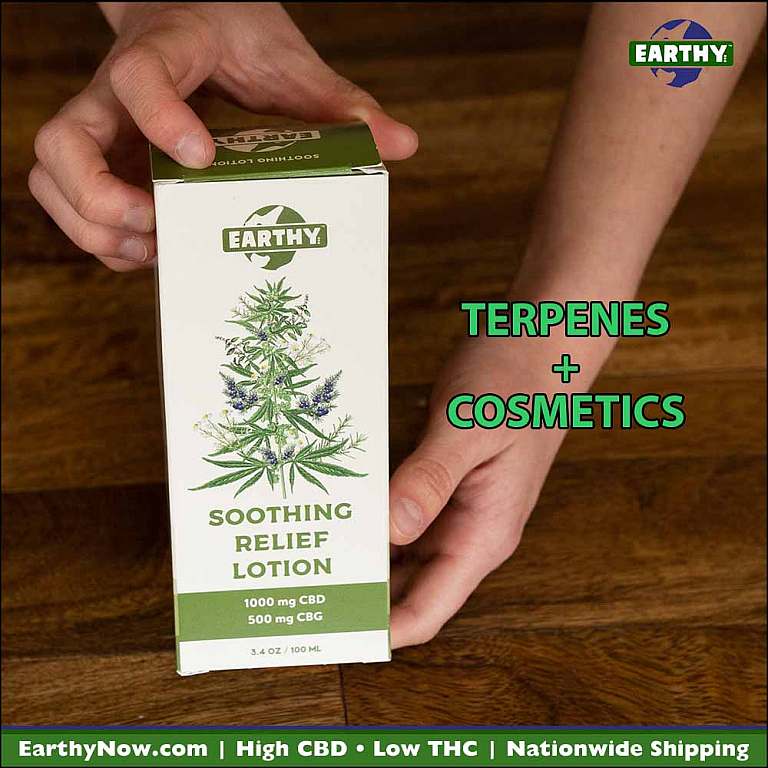Terpenes have been a staple of cosmetics for as long as people have wanted to smell good—basically throughout history. The truth is, we do our best to smell fresh and pleasing, so why not add our favorite pleasing and fresh scents to the products we use on our bodies?
Even in biblical times, people sought a pleasant scent in their grooming products by using essential oils, which are what terpenes are derived from. For instance, in the Old Testament’s Song of Songs, the bridegroom delights in the smells of his beloved, the fragrance of your garments is like the fragrance of Lebanon, nard, myrrh, and all the finest spices. In essence, the bride had bathed or washed her clothes with terpene-infused products, though, of course, they would not have called it that.
All this is to say that terpenes have been a part of our bodily rituals for a very long time.
Are we living on planet terpene?
In these modern times, the scents of our cosmetics options are practically infinite, thanks to botanical terpene extraction on a grand scale. Lavender, vanilla, lilac, and rose are among some of the most popular fragrances in the cosmetics industry. But, what about cannabis-derived terpenes?
Do we want to smell like different cannabis strains? The popularity of new terpene-infused cosmetics suggests we do indeed. In fact, cosmetics companies are just beginning to discover how much consumers do want their skin, hair care, and beauty products to give off these familiar rich aromas. However, it remains to be seen which cannabis terpenes will ultimately rise to the top in this exciting new world of cosmetics fragrances.
What are terpenes?
Terpenes are in our food, the flowers we smell, and, yes, the cosmetic products we use. They are simply the chemical compounds found in plants which affect the way they smell and taste. Cannabis plants happen to contain high concentrations of these aromatic compounds.
Different terpene profiles in nature determine the characteristic aromas of plants. For instance, the common terpene linalool gives lavender its distinctive floral scent, and the terpene alpha-pinene contributes to the woody, earthy aroma of pine needles and rosemary.
What’s more, the scent of a plant can help it survive. Terpenes can protect plants from being eaten by insects or other animals by giving off a scent that repels the would-be pests [1]. In another helpful technique, terpenes like the terpene limonene, found in citrus fruits and other plants, may emit pleasing aromas to attract pollinators.
Are terpenes and essential oils the same?
Terpenes are the primary constituents of essential oils, yet there are some key differences. The main difference is that essential oils contain all of the main components of a particular plant species, while terpenes are isolated from the other components.
By extracting only the terpenes from a given plant, as opposed to extracting the essential oil in its entirety, people are able to mix and match different terpenes to create more complex scents. To use a cooking metaphor, lemons are just one ingredient in lemon meringue pie just as the terpene pinene is just one component of the essential oil of pine trees.
Four common ingredients in cosmetics
There are four main categories of ingredients when it comes to cosmetics:
- Surfactants
- Conditioning polymers
- Preservatives
- Fragrances
It’s important for consumers to understand what these basic ingredients are in order to make decisions about which cosmetics are safest and most useful for them.
Found in products used for washing, surfactants break up oily substances that collect on the skin. They can be washed away with water and are often combined with additives like salts, dyes, or perfumes in products like makeup, cleansing gel, shampoo, and lotion. Additionally, surfactants help to thicken products, allowing them to spread more evenly and foam when lathered [2].
Conditioning polymers are used widely in skincare product production because they help maintain moisture. A natural component of vegetable oils and animal fats, glycerin is one of the most popular and cost effective conditioning polymers and can now be produced synthetically. Also used in hair products to attract water, conditioning polymers soften the hair by swelling the hair shaft. They keep cosmetics from drying out and stabilize fragrances so they don’t seep through bottles [2].
Preservatives keep cosmetics from going bad. They serve to slow the growth of harmful bacteria and prolong a product’s shelf life. Additionally, they can help keep a product from causing infections on the skin or in the eyes [2].
Our sense of smell is often the first sense we engage to learn about a person or product, so fragrance is extremely important. Though a particular fragrance can make a product especially desirable, some fragrances can be harmful. That’s why natural fragrances such as essential oils or terpenes are some of the best ingredients with which to scent a cosmetic product. Synthetic fragrances can contain harmful chemicals that may cause allergic reactions so avoiding them may be better.
When it comes to scenting cosmetics with cannabis terpenes, it’s important to preserve the pure aromas through a careful extraction process. Too much heat or pressure can lead to the breakdown of the terpenes’ chemical structure. Thus, it’s important to buy high-quality terpenes from reputable companies. Look for a terpene’s certificate of analysis (COA). A COA is a document attesting to a product’s laboratory analysis for cannabinoids and in some cases adulterants [3].” A company should post its products’ COAs publicly for transparency and confidence in the product. Earthy Terpenes are 100% cannabis-derived, all-natural, strain-specific, with no additives.
What’s the purpose of terpenes and essential oils in cosmetics?
Overall, the role of terpenes and essential oils in cosmetics is to make the product smell good. However, there are also potential benefits associated with each of them. For instance, cosmetic formulations that include linalool, the main terpene found in lavender essential oil, may be calming to the human body. Other terpenes such as myrcene may also prove beneficial to the skin [4].
Certain terpenes absorb into the skin more readily, so it’s important to know which different terpenes have been added to a given product in order to understand how the most common terpenes might provide benefits.
Examining the Effects of Cannabis on Skin Conditions
Cannabis-derived terpenes vs. botanical terpenes
Though all the terpenes in cannabis are technically botanically-derived, since cannabis is a plant, the cannabis industry has come to differentiate between cannabis-derived terpenes and botanical-derived (non-cannabis-derived) terpenes. Cannabis terpenes and botanical terpenes share many of the same terpenes. For example, alpha-pinene, which is abundant in mint plants, is also at a high level in cannabis strains such as Hawaiian Haze and Canna Cake.
Natural Solutions: The Role of CBD Oil in Pet Care
Will this lotion get me high?
Terpenes in and of themselves cannot get you high. However, skin cells will likely absorb some of the terpenes in the product, which can work in the same way on your cell receptors as essential oils. For example, terpenes such as linalool can be absorbed through the skin surface and can potentially calm the mind and body.
In contrast, if your cosmetic product contains cannabinoids such as THC or full spectrum CBD , terpenes may influence the way you experience the effects of these by way of the entourage effect. The entourage effect proposes that when different compounds of the cannabis plant are taken together, they can enhance the benefits of the cannabinoids [5].
Cannabis, hemp, marijuana and the Farm Bills
Marijuana and hemp both come from the cannabis plant, yet the law treats them quite differently. The 2014 and 2018 Farm Bills established new federal legal definitions and rules for hemp, including the allowance that hemp “and any part of that plant, including the seeds thereof and all derivatives, extracts, cannabinoids, isomers, acids, salts, and salts of isomers, whether growing or not, with a Delta-9 tetrahydrocannabinol concentration of not more than .3% on a dry weight basis” may be legally produced, sold, transported and used.
Simply put, cannabis with less than .3% Delta-9 THC is defined as hemp, while cannabis with more than .3% Delta-9 THC is defined as marijuana. Marijuana and hemp both contain terpenes. However, the main difference between the two plants is the type of cannabinoids traditionally associated with them.
The most well-known cannabinoids in cannabis are cannabidiol (CBD) and tetrahydrocannabinol (THC). CBD on its own is non-psychoactive, whereas THC is psychoactive. Full spectrum CBD is made up of material from the entire plant, including minor cannabinoids and trace amounts of Delta-9 THC. Many if not all cannabinoids, including CBD, CBG, CBN, Delta-8 THC, Delta-10 THC, and even Delta-9 THC, may be derived from federally compliant hemp.
Are terpenes & the entourage effect related?
There is some evidence to indicate terpenes influence the entourage effect, the way in which cannabis compounds—like cannabinoids, flavonoids, and terpenes—work synergistically in the endocannabinoid system to enhance the overall effect of the plant on the body [5].
The entourage effect, in relation to cannabis, was first coined by Mechoulam and Ben-Shabat in their 1998 hypothesis that proposed other organic compounds work in tandem with the primary endogenous cannabinoids, thereby enhancing the effects of cannabis.
Cannabinoids don’t seem to work in the same way without the entourage effect. For instance, scientists have found that the mixture of all the components of the plant has different effects than isolated compounds. GW Pharmaceuticals, makers of one of the only sanctioned cannabis-based drugs Sativex (called Nabiximols in the U.S.), found that a whole plant extract was more effective than a single compound for certain therapies. Another researcher noted that single-component drugs like Marinol, a synthetic THC pill, have less therapeutic value than those with more cannabinoids [6].
Still, research on the entourage effect is in its infancy and some scientists seek more data to be fully convinced [7]. However, many cannabis proponents lean on the existing data, as well as popular anecdotal notions of the entourage effect, and embrace the opportunity to create custom blends of terpenes and cannabinoids to offer consumers specifically designed effects [8].
Are terpenes safe to use in cosmetics?
If used properly, many terpenes are safe to use in cosmetic products. While some terpenes are known for irritating the skin, the severity of the irritation is linked to higher concentrations of them. That’s why it’s important for terpenes to be appropriately diluted in products used for skin care. What’s more, proper storage of terpenes is required to preserve their purity and decrease the risk of adverse skin reactions [9].
The International Fragrance Association (IFRA) specifies which terpenes represent a potential allergy risk as well as states the maximum concentration of them allowed in a product in order to produce safe cosmetics [9].
Naturally pure: benefits of terpenes in cosmetics
The most notable benefit of terpenes in cosmetics is their ability to make our grooming products smell good. The aroma of limonene, for example, can make a lotion smell pleasantly of citrus. Or, nerolidol might make a cleanser or shampoo evoke the smell of orange blossom. A pleasing aroma promotes relaxation and can make you feel good, providing a sense of overall wellness.
Moreover, terpenes can penetrate the body’s largest organ—the skin—and may enhance the transdermal delivery of certain lipids, vitamins, minerals, and potentially cannabinoids [10].
Terpenes in cosmetics
There’s a good reason that throughout history civilizations have used essential oils and their terpene constituents as ingredients for bathing and grooming products. We simply feel better (and cleaner) when we smell better. Unsurprisingly, this tradition has survived, and today terpenes and essential oils are still the most widely used natural ingredients in the cosmetic and perfumery industries.
Terpenes & oral care
Toothpaste and oral care products can benefit from the addition of terpenes in several ways. First of all, certain terpenes like linalool, camphene, and alpha-pinene give a fresh taste to our mouths, improving our breath and getting rid of the stale taste that can accumulate there after a period of time. Secondly, certain terpenes like limonene show more promise yet more research is needed [11].
Terpenes & skin health
Terpenes have been added to skincare products throughout history to make them smell fresh and desirable. But they may provide other benefits related to skin [13].
Terpenes & sun care
Applying sunscreen regularly is an important way to help you avoid sunburn. Adding terpenes to sunscreen can make these products smell good as well as offer other potential benefits [14].
Terpenes & hair care
Who doesn’t love to burrow their nose into freshly washed hair and breathe in the aroma? Let’s face it, modern humans want to have good-smelling hair. That’s why terpenes are such popular ingredients for shampoos and conditioners. Yet, cannabis terpenes can offer even more to our heads than their wonderful smells [15].
Terpenes & body care
Terpenes are a great addition to body care products such as salves and massage oils because of their effects, as well as their aromatic benefits. When these products also contain cannabinoids such as THC or CBD, the effects of the terpenes may be even more beneficial because of the entourage effect.
Closing thoughts on terpenes in cosmetic products
The cosmetic industry is just beginning to discover the enormous potential of cannabis-derived terpenes for skin care, decorative cosmetics, hair products, and cleansers. It’s becoming clear that adding terpenes to cosmetics is simply the next step in the evolution of restorative products for the body.
The amazing benefits that terpenes lend to cosmetics are likely to make them even bigger stars in the ingredient lists than essential oils. Indeed, cosmetics are no longer just about making your body look and smell good. They’re becoming more about making you feel good too.
Limonene: Everything You Need to Know
Disclaimer – Information is provided for educational purposes. It does not, and is not intended to, constitute legal advice or medical advice. We attempt to be accurate and up to date but the legality of cannabinoids and the science of cannabis is evolving. The author is neither a legal expert nor a medical expert. You should check with your local authorities and medical providers before buying or using any products.
References
- Wikipedia: Terpene
- Understanding Beauty Skin Care Cosmetics and Makeup
- Wikipedia: Certificate of Analysis
- Anti Aging Human Skin
- Wikipedia: Entourage Effect
- CNN: Gupta on Marijuana Entourage Effect
- Are Parts of Marijuana’s Entourage Effect Scientifically Valid?
- Safety Standards for Terpene Limits in Cannabis Manufacturing
- Status of Terpenes as Skin Penetration Enhancers
- Effects of Limonene in Toothpaste
- Antioxidants and Antibacterial Properties of Seven Predominant Terpinoids
- Anti Aging in Human Skin
- Cannabis Terpenes may be the Key to Stopping Scalp Fungus






